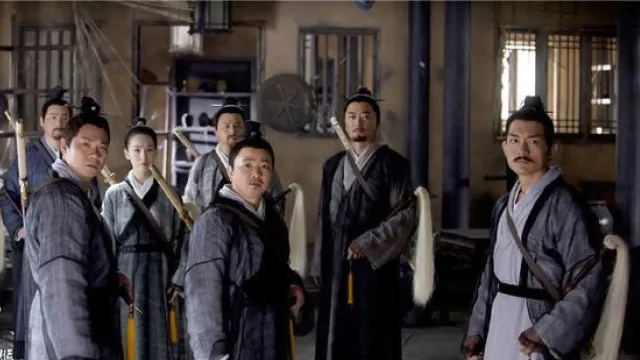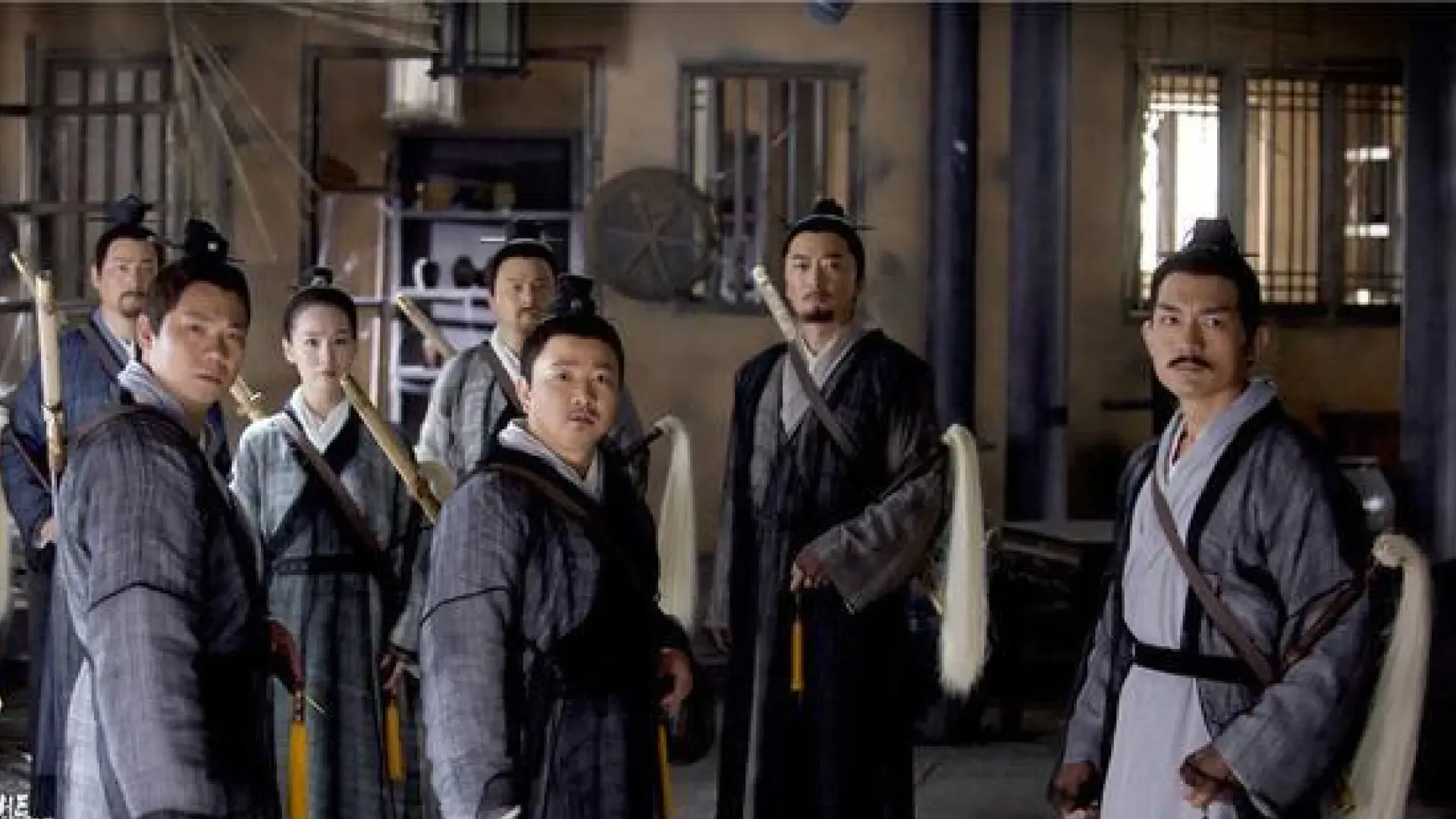Hao Datong (simplified: 郝大通, traditional: 郝大通, pinyin: Hǎo Dàtōng, jyutping: hou2 daai6 tung4), known by his Daoist name Guangningzi (广宁子 – Guǎngníngzǐ), was one of the Seven Zis of Quanzhen and a significant figure in the expansion of the Quanzhen Order’s influence throughout northern China. A disciple of Wang Chongyang, the Central Divine of the Five Greats, Hao Datong distinguished himself as a founder and regional leader who successfully adapted Quanzhen teachings to local conditions and terrain.1
His most notable achievement was founding the Huashan School, a sub-school of the Quanzhen Order that developed specialized sword techniques adapted to mountain terrain. His martial abilities were considered to be on par with formidable opponents like Huo Dou and Daerba, demonstrating his significant fighting prowess among the Seven Zis. His administrative skills and regional expertise made him instrumental in spreading Quanzhen influence across vast geographical areas during the Order’s period of expansion.
Biography
Early life and discipleship
Hao Datong entered the Quanzhen Order during Wang Chongyang’s recruitment of the most promising disciples in Shandong Province. Selected for his combination of martial potential and administrative capabilities, he became one of the seven core disciples who would later lead the Order after their master’s death.
Under Wang Chongyang’s tutelage, he mastered the fundamental Innate Skill and various Quanzhen martial arts techniques. His Daoist name “Guangningzi” (广宁子), meaning “Broad Tranquility Master,” reflected his temperament and his ability to maintain calm effectiveness in diverse and challenging situations.
Among the Seven Zis, Hao Datong showed particular aptitude for understanding how martial arts techniques could be adapted to different geographical conditions and how organisational structures could be modified to serve local communities while maintaining central doctrinal unity.
Founding of the Huashan School
One of Hao Datong’s most significant contributions to the Quanzhen Order was his establishment of the Huashan School (also known as Huashan Daoism), a specialized branch that developed unique approaches to martial arts training based on mountain terrain and conditions. The school was founded on Mount Hua, one of China’s Five Great Mountains, which provided an ideal environment for developing advanced techniques.
The Huashan School under Hao Datong’s leadership developed sword techniques specifically adapted to mountain combat, including methods for fighting on steep slopes, narrow ledges, and rocky terrain. These innovations reflected Hao’s understanding that effective martial arts required adaptation to environmental conditions rather than rigid adherence to standardized forms.
The school also served as a model for regional adaptation within the Quanzhen Order, demonstrating how the core principles of Wang Chongyang’s teachings could be maintained while allowing for local innovations that enhanced effectiveness. This balance between tradition and adaptation became an important precedent for other Quanzhen branches.
Regional leadership and expansion
Hao Datong’s role in the Quanzhen Order extended beyond martial arts instruction to include significant administrative responsibilities for expanding the Order’s influence throughout northern China. His work involved establishing training centers, coordinating with local authorities, and ensuring that new branches maintained doctrinal consistency while adapting to local conditions.
His regional expertise proved particularly valuable during periods of political instability when the Quanzhen Order needed to maintain its operations across territories controlled by different rulers. Hao’s diplomatic skills and understanding of local customs enabled the Order to continue its activities even during times of conflict and political change.
The success of his regional branches demonstrated the effectiveness of decentralized leadership within a unified organisational structure, providing a model that influenced Chinese martial arts organisations for generations.
Martial arts development
Throughout his career, Hao Datong maintained focus on practical martial arts development that emphasized effectiveness over purely aesthetic considerations. His approach to training reflected the practical needs of martial artists who might need to fight in diverse environments and circumstances.
His innovations in mountain-terrain techniques influenced not only the Huashan School but also the broader development of Chinese martial arts, as other schools began to consider how environmental factors should influence technical development. This practical approach earned him respect throughout the jianghu and established his reputation as both an effective fighter and an innovative teacher.
His martial abilities were noted to be comparable to those of Huo Dou and Daerba, placing him among the more formidable fighters of his generation. This combat effectiveness, combined with his administrative skills, made him particularly valuable to the Quanzhen Order during its expansion period.
Later years and continued influence
As the Quanzhen Order matured and faced new challenges, Hao Datong’s experience in regional adaptation became increasingly important. His ability to maintain organisational unity while allowing for local variation provided stability during periods when other martial arts organisations were fragmenting due to internal conflicts or external pressures.
His continued leadership of the Huashan School demonstrated the long-term viability of his approach to regional adaptation, as the school maintained its distinctive character while remaining integrated with the larger Quanzhen Order. This success provided validation for his organisational philosophy and influenced subsequent leadership decisions within the Order.
Personality and traits
Adaptability and pragmatism
Hao Datong possessed exceptional adaptability that distinguished him from some of his more doctrinaire martial brothers. While maintaining firm commitment to core Quanzhen principles, he demonstrated remarkable flexibility in implementing these principles under diverse conditions and circumstances.
His pragmatic approach to martial arts and organisation made him particularly effective in situations that required creative problem-solving rather than rigid adherence to established procedures. This flexibility proved essential during the Quanzhen Order’s expansion into new territories with different local customs and conditions.
Administrative vision
Unlike some martial artists who focused primarily on personal cultivation, Hao Datong demonstrated exceptional understanding of organisational dynamics and the requirements for maintaining effective large-scale operations. His vision extended beyond immediate martial concerns to encompass long-term institutional sustainability.
His success in founding and maintaining the Huashan School reflected sophisticated understanding of how to balance autonomy with coordination, allowing local innovation while maintaining doctrinal consistency. This administrative wisdom contributed significantly to the Quanzhen Order’s overall success during its period of rapid expansion.
Regional sensitivity
Hao Datong’s effectiveness as a regional leader reflected his genuine appreciation for local traditions and his ability to find common ground between Quanzhen teachings and existing community values. Rather than imposing uniform practices, he sought to demonstrate how Quanzhen principles could enhance rather than replace local martial traditions.
This cultural sensitivity made him particularly effective as an ambassador for the Quanzhen Order, helping to overcome resistance that might have emerged if the Order had taken a more rigid or dismissive approach to local customs and practices.
Martial arts abilities
Quanzhen foundational arts
As one of Wang Chongyang’s direct disciples, Hao Datong mastered the profound Innate Skill that formed the foundation of all Quanzhen martial arts. His qi cultivation reached levels that supported both his personal martial effectiveness and his ability to teach advanced techniques to others.
The Innate Skill provided Hao with the energy foundation necessary for adapting techniques to challenging mountain terrain, where ordinary martial artists might find themselves quickly exhausted by the physical demands of high-altitude combat and steep-slope maneuvering.
Mountain-adapted techniques
Hao Datong’s innovations in mountain-terrain martial arts represented a significant contribution to Chinese fighting methods. His techniques included adaptations for fighting on narrow ledges, steep slopes, and rocky surfaces where traditional flat-ground methods would be ineffective or dangerous.
These mountain techniques required exceptional balance, precise footwork, and modified sword angles that took advantage of gravitational effects and terrain features. The innovations proved so effective that they influenced martial arts development well beyond the Quanzhen Order’s immediate sphere of influence.
Huashan School swordplay
The sword techniques developed under Hao Datong’s leadership at the Huashan School emphasized practical effectiveness adapted to mountainous conditions. These methods integrated traditional Quanzhen sword principles with innovations designed specifically for the unique challenges of mountain combat.
The Huashan swordplay became renowned for its versatility and effectiveness, demonstrating that adaptation to local conditions could enhance rather than compromise martial effectiveness. The techniques proved suitable for both mountain and flat-ground combat, providing practitioners with superior versatility.
Big Dipper Formation participation
As one of the Seven Zis, Hao Datong participated in the legendary Big Dipper Formation, occupying a position that utilized his adaptability and practical combat skills. Within the formation, his role involved providing flexible response capabilities that could adapt to changing tactical conditions.
His performance in the formation demonstrated how individual specialization could contribute to collective effectiveness without compromising the formation’s overall integrity. His mountain-combat experience proved particularly valuable when the formation needed to operate in challenging terrain.
Combat effectiveness
Hao Datong’s martial abilities were noted to be comparable to those of Huo Dou and Daerba, both formidable fighters in their own right. This comparison placed him among the more capable combatants of his generation and validated his approach to practical martial arts development.
His combat effectiveness reflected not only technical skill but also strategic thinking that allowed him to maximize advantages while minimizing weaknesses. This tactical awareness contributed to both his personal fighting ability and his success as a teacher and regional leader.
Relationships
Wang Chongyang
Hao Datong’s relationship with his shifu2 Wang Chongyang was characterized by mutual appreciation for practical effectiveness and organisational vision. Wang recognized Hao’s administrative talents and encouraged his development of regional adaptation strategies that would prove crucial to the Order’s expansion.
Under Wang’s guidance, Hao developed both his martial abilities and his understanding of how individual innovation could serve collective goals. This relationship provided the foundation for his later success in founding and leading the Huashan School while maintaining integration with the larger Quanzhen Order.
The Seven Zis
Among his martial siblings, Hao Datong maintained relationships characterized by mutual respect and complementary contributions to the Order’s overall mission. His practical approach balanced the various specializations of Ma Yu, Tan Chuduan, Liu Chuxuan, Qiu Chuji, Wang Chuyi, and Sun Bu’er.
His compatibility with Qiu Chuji and Wang Chuyi was particularly noted, suggesting shared practical orientations that strengthened their collective effectiveness. These relationships demonstrated how diverse approaches could enhance rather than conflict with each other when unified by common purposes.
Regional disciples and associates
Hao Datong’s role as a regional leader required him to develop relationships with local martial artists, community leaders, and government officials. His success in these interactions reflected both his diplomatic skills and his genuine respect for local traditions and concerns.
His ability to build these regional networks proved crucial to the Quanzhen Order’s expansion and demonstrated the importance of local relationships in maintaining effective martial arts organisations. These connections provided both immediate operational benefits and long-term institutional stability.
Behind the scenes
Legacy and influence
Hao Datong’s success in founding and leading the Huashan School provided a model for regional adaptation within martial arts organisations that influenced Chinese martial development for centuries. His demonstration that local innovation could enhance rather than compromise doctrinal integrity became an important precedent.
The Huashan School’s continued success validated his approach to balancing autonomy with coordination, showing how large organisations could maintain unity while allowing for beneficial local variation. This model influenced numerous subsequent martial arts schools and organisations.
Mountain combat techniques
The mountain-adapted techniques developed under Hao’s leadership became influential throughout the Chinese martial arts world, providing effective methods for combat in challenging terrain. These innovations demonstrated the importance of environmental adaptation in martial arts development.
His technical contributions proved that innovation based on practical necessity could enhance traditional methods rather than replacing them, providing a model for how martial arts could evolve while maintaining their essential characteristics.
Administrative philosophy
Hao Datong’s administrative approach demonstrated how effective leadership could balance central coordination with local autonomy, providing stability and flexibility simultaneously. His methods influenced organisational development within the martial arts world and beyond.
His success showed that administrative skill was as important as martial prowess for maintaining effective martial arts organisations, encouraging future leaders to develop both capabilities rather than focusing exclusively on fighting ability.
Hao Datong represents Jin Yong’s exploration of how martial arts organisations can maintain unity while adapting to diverse local conditions. His character demonstrates the importance of administrative skill and regional sensitivity in building and maintaining effective martial arts institutions.
The historical Hao Datong (1140-1213) was indeed one of the Seven Masters of Quanzhen and founder of the Huashan branch of the Order. Jin Yong’s portrayal draws on this historical foundation while emphasizing the practical and administrative aspects of his contributions to the Order’s success.
His comparison to characters like Huo Dou and Daerba serves to establish his martial credibility while showing that administrative leaders within martial arts organisations could also be formidable fighters. This combination of skills makes him an important example of well-rounded martial arts leadership.
The founding of the Huashan School provides Jin Yong with opportunities to explore themes of tradition and adaptation, showing how authentic development can occur within established frameworks when guided by practical wisdom and genuine respect for foundational principles.
Portrayals
Hao Datong has appeared in various television and film adaptations of Jin Yong’s novels:
The Legend of the Condor Heroes
- 1983 series – Cheung Gong
- 1994 series – Ng Wai-kwok
- 2003 series – Zhang Zhizhong
- 2008 series – Yu Shaoqun
- 2017 series – Chen Zihan
The Return of the Condor Heroes
Most portrayals emphasize his practical nature and administrative capabilities among the Seven Zis, often depicting him as a reliable and competent leader who balances martial prowess with organisational wisdom.
See also
- The Legend of the Condor Heroes characters
- The Return of the Condor Heroes characters
- Wang Chongyang – His master
- Seven Zis of Quanzhen – His faction
- Quanzhen Order – His sect
- Huashan School – His branch
- Qiu Chuji – His martial brother
- Wang Chuyi – His martial brother
External links
- Hao Datong on Wikipedia
- Hao Datong (Chinese) on Chinese Wikipedia
- Hao Datong (Chinese) on Baidu Baike
Footnotes
-
江湖 – jiānghú. The world of martial arts. A sub-society involving all who are related to the martial arts scene. What is jianghu? ↩
-
师父 – shīfū. Teacher or master responsible for technical instruction and moral guidance. Shī means teacher. Fū means father. See Wuxia Wiki. ↩


